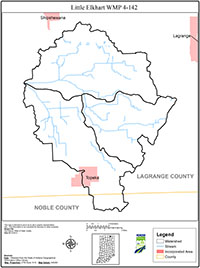Summary
The LaGrange County Soil and Water Conservation District (SWCD) reviewed its water quality improvement efforts across the county to determine areas that need additional focus. The eastern portion contains the “lake country” and has been the center of attention of for many years with numerous projects implementing water quality improvement practices designed to reduce non-point source pollution. The western portion of the county has received less attention and that convinced the LaGrange County SWCD staff to focus its next major project in this region of the county. The Little Elkhart River drainage constitutes a major portion of western LaGrange County and was selected as a focal watershed. The Little Elkhart River system presents unique challenges with the preponderance of landowners belonging to the Amish community. Traditionally they have been reluctant to accept federal/state cost-share funds for conservation-based projects. However, the six county Indiana SWCDs that lie within the St. Joseph River Basin have an on-going 319 Grant (administered by LaGrange County SWCD) for Livestock Management within the basin. Since 1999, the livestock specialist working in conjunction with NRCS and SWCD staff has established a close relationship with the Amish community opening the opportunity to develop and implement a long-range, detailed plan for the watershed.
The Little Elkhart River is a sub-watershed within the St. Joseph River Basin. The St. Joseph River has received significant attention in its urbanized centers of South Bend, Mishawaka, and Elkhart concerning water quality issues initially associated with point source pollution. A relatively recent focus has centered on non-point source pollution throughout the basin with an emphasis centered in areas where agriculture is the main land use practice. Studies conducted by Indiana and Michigan state/county agencies have demonstrated tributaries of the mainstream are the major contributor of non-point source pollutants.
The Little Elkhart River is primarily influenced by agricultural practices and is on the IDEM 303(d) list of impaired waters. The focus of this plan is on the headwaters located in western LaGrange County with a small portion extending into Noble County. The target area is defined by the hydrologic unit codes Bontrager Ditch-Emma Lake, Bontrager Ditch-Hostetler Ditch, and the Little Elkhart River Ditch (Topeka). Combined, these three sub-watersheds of the Little Elkhart River total 33, 814 acres. These headwaters are influenced by agricultural practices, a growing “cottage” industry, septic systems, and an increase of impervious surfaces near the ditches. Previous water quality testing has shown high levels of phosphate, nitrate, e-coli and impaired biotic communities. Emma Lake, which lies within Bontrager Ditch-Emma Lake, is listed on the IDEM 303(d) list of impaired waters for E. coli.
Although much attention is given to organic compounds and bacteria pollutants, Indiana Department of Natural Resource studies have indicated silt loading as a major limiting factor on the fish community within the Little Elkhart River system. Ledet (1991) listed the Little Elkhart River as a cool to cold water environment but silt loading prevented fish species usually associated from becoming established.
Building partnerships within the target area and with leadership that influence plan implementation is crucial for its success as a template to improve water quality in the Little Elkhart River drainage. Partnerships were successfully achieved with an aggressive mailing campaign, numerous public meetings, and announcements of the plan at other county functions, newspaper articles, and one-on-one contacts with landowners residing in the sub-watersheds. As a result of the outreach program the public is well aware of the plan, its purpose, and what it can do for them in the quest for cleaner water.

